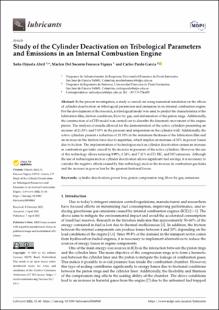study of the Cylinder Deactivation on Tribological Parameters and Emissions in an Internal Combustion Engine
Artículo de revista
2022-04-07
Lubricantes
Suiza
In the present investigation, a study is carried out using numerical simulation on the effects
of cylinder deactivation on tribological parameters and emissions in an internal combustion engine.
For the development of the research, a tribological model was used to predict the characteristics of the
lubrication film, friction conditions, blow-by gas, and deformation of the piston rings. Additionally,
the construction of a CFD model was carried out to describe the kinematic movement of the engine
piston. The analysis of results allowed for the demonstration of the active cylinders presenting an
increase of 21.53% and 7.65% in the pressure and temperature in the cylinder wall. Additionally, the
active cylinders present a reduction of 11.33% in the minimum thickness of the lubrication film and
an increase in the friction force due to asperities, which implies an increase of 33% in power losses
due to friction. The implementation of technologies such as cylinder deactivation causes an increase
in combustion gas leaks caused by the increase in pressure of the active cylinders. However, the use
of this technology allows reducing 9.09%, 8.26%, and 7.41% in CO, HC, and NO emissions. Although
the use of technologies such as cylinder deactivation allows significant fuel savings, it is necessary to
consider the negative effects caused by this technology, such as the increase in combustion gas leaks
and the increase in power loss by the greatest frictional forces.
Descripción:
Study of the Cylinder Deactivation on Tribological Parameters and Emissions in an Internal Combustion Engine.pdf
Título: Study of the Cylinder Deactivation on Tribological Parameters and Emissions in an Internal Combustion Engine.pdf
Tamaño: 37.13Mb
 PDF
PDF
 LEER EN FLIP
LEER EN FLIP
Título: Study of the Cylinder Deactivation on Tribological Parameters and Emissions in an Internal Combustion Engine.pdf
Tamaño: 37.13Mb
 PDF
PDF
 LEER EN FLIP
LEER EN FLIP

















